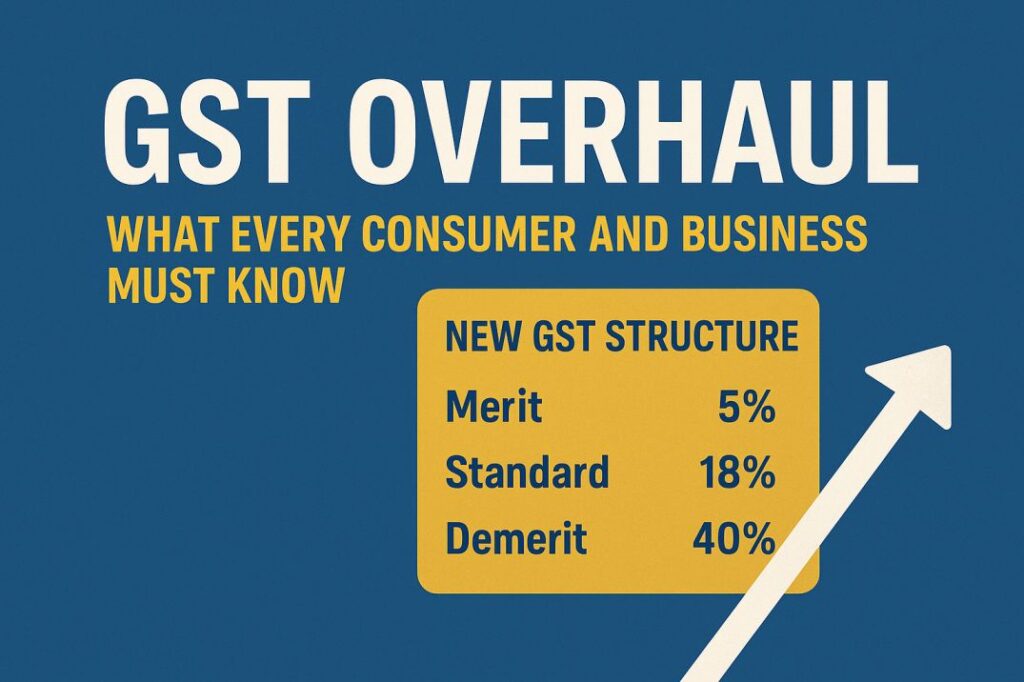It’s here. The biggest GST shakeup in India’s history is coming into force on September 22, 2025, and if you think it’s just another tax change, think again.
This is not merely a rate adjustment—it’s a complete tax reset designed to simplify your life, but also force you to rethink what you buy and sell.
Whether you run a business, are a consumer, or are just someone who pays for everyday goods, understanding this shift can help you make smarter financial decisions, save money, and avoid costly surprises.
Let’s cut through the jargon, hit the numbers, and show exactly how this impacts your wallet and business.
✅ The New GST Tax Structure: Forget the Old Confusion
👉 Instead of juggling 5-6 tax slabs, we now have a simplified, powerful 3-slab system:
| Type | GST Rate | What It Covers |
|---|---|---|
| Merit | 5% | Essentials like food, healthcare devices, farming equipment |
| Standard | 18% | Most manufactured goods and services |
| Demerit | 40% | Luxury goods, sin products (tobacco, pan masala, large vehicles) |
Plus:
✔ Nil-rated items: Life-saving drugs, schoolbooks, and basic food essentials.
✔ Special Cess: Continues on select sin goods and luxury items (up to 204%).
📊 Real-World Impact: A Simple Calculation You Must See
Let’s imagine two popular purchases and see how the tax impact changed before vs. after Sept 22, 2025.
1. A Tractor – Agricultural Lifeline
- Previous GST: 12%
- New GST: 5%
💸 On a ₹10 lakh tractor:
- Before: ₹10,00,000 × 12% = ₹1,20,000 GST → Final Cost: ₹11,20,000
- Now: ₹10,00,000 × 5% = ₹50,000 GST → Final Cost: ₹10,50,000
✅ Immediate Saving: ₹70,000
This means a substantial cut in input costs for farmers, improving affordability and promoting mechanization.
2. Pan Masala – A Sin Product
- Previous GST: 28%
- New GST: 40% + Cess
Let’s say base price is ₹100.
- Before: ₹100 × 28% = ₹28 → Final Price: ₹128
- Now: ₹100 × 40% = ₹40 → Final Price: ₹140
Plus, if a cess applies (let’s say 100% for simplicity), an additional ₹100 is added, totaling ₹240.
⚠️ Price Surge: Nearly Double
The government is aggressively discouraging consumption of harmful products by hiking the tax.
🎯 The Hidden Winner: Small Businesses & Essential Services
✔ Businesses with turnover < ₹2 crore can now opt for a simplified composition scheme at rates between 1.5% and 6%, giving massive relief from complex tax filing.
✔ Job work in textiles, pharmaceuticals, and leather industries is now taxed at just 5% GST instead of 12%-18% earlier.
✔ Healthcare items like thermometers, glucometers, test strips now attract only 5% GST instead of 18%, dramatically lowering the cost for clinics and hospitals.
🚀 Why This is a Game-Changer – Shareable Insight
🔍 Here’s the powerful takeaway you must share:
👉 “A ₹1,00,000 purchase of essential farming equipment now saves ₹7,000 in taxes overnight.”
👉 “Luxury cars and tobacco face an unprecedented 40% GST, reshaping consumer behavior.”
👉 “Your smartphone remains at 18%, but your daily staples are now cheaper.”
And the best part:
🌱 This isn’t inflationary. It’s actually designed to reduce the cost of living for essentials while targeting sin goods and luxury items for higher tax collection.
⚡ What Should You Do Right Now?
- ✅ For Consumers
- ✔ Buy Essential Goods After the Change
- Items like agricultural equipment, healthcare devices (thermometers, glucometers, feeding bottles), and basic school supplies now attract a lower 5% GST rate instead of 12%-18%.
- 💡 Unless you urgently need them now, it makes sense to wait and purchase after the new rates apply, saving you money.
- ⚠️ Luxury & Sin Goods Will Get Much More Expensive
- Products such as tobacco, pan masala, large motorcycles, yachts, and gambling services will face a steep 40% GST rate (plus cess).
- 👉 Prices of these items will rise sharply after the change, making them significantly costlier.
- 📢 If you are considering purchasing such products, do so well before the new tax rates kick in to avoid paying the higher tax.
- ✅ For Businesses
- Update your invoicing systems to reflect the new GST rates.
- Recalculate your cost structure, especially if you’re in agriculture, healthcare, or manufacturing.
- Plan your inventory based on shifting tax burdens.
🎁 Pro Tip: Tax Planning Edge
Let’s say your business purchases ₹5 lakh worth of syringes (healthcare equipment).
- Old GST (12%): ₹60,000 tax.
- New GST (5%): ₹25,000 tax.
💡 You save ₹35,000 instantly.
Proactively adjusting your purchases and supply chain now can maximize savings before Sept 22.
🚨 Final Verdict: This Is a Must-Share Insight
👉 Everyone will feel this change—from shopkeepers and farmers to large corporations and consumers.
💡 Bookmark this as the most straightforward, easy-to-understand guide to GST reforms.
📣 Don’t keep this to yourself. Share it with your business partners, colleagues, and family.
The tax landscape has changed forever. Smart decisions today mean more savings tomorrow.

